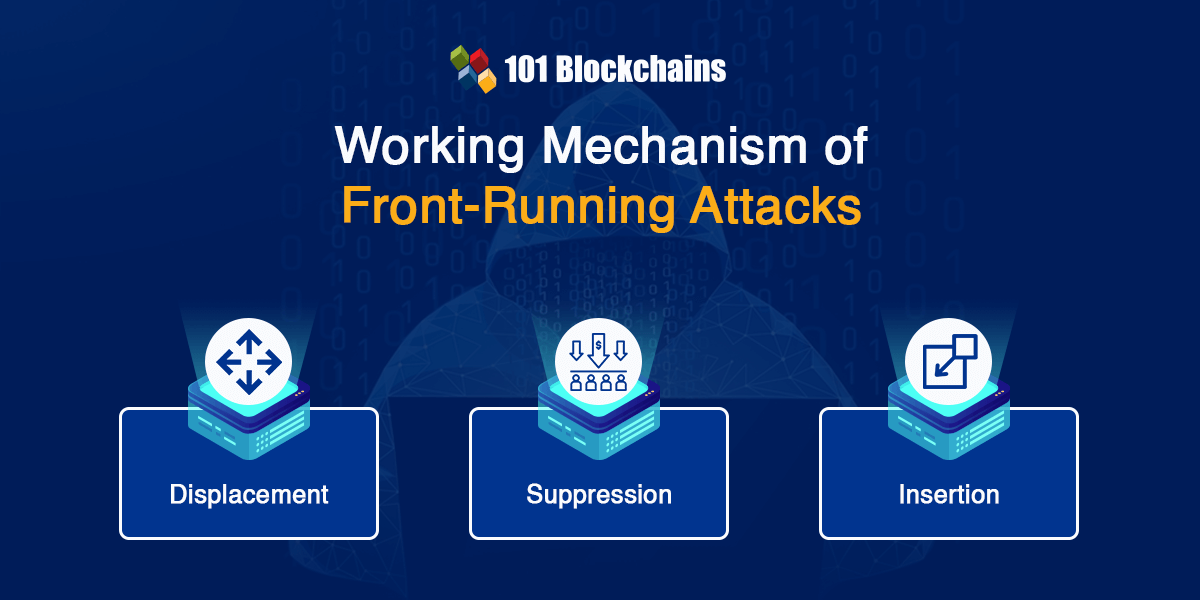Learn how blockchain truly works, master key definitions, and uncover what makes smart contracts so "smart." Dive into the fundamentals, gain valuable insights, and start your blockchain journey today!

- Blockchain
Georgia Weston
- on December 18, 2023
Front-Running Attacks in Blockchain: A Complete Guide
Unethical practices always pose a threat to every industry. Front-running is one of the illegal practices you might come across in traditional stock markets. It involves a market participant engaging in trades based on prior awareness of pending orders by other clients. The same principle is applicable in the case of blockchain front-running attacks when a malicious actor could place their transactions ahead of other users.
Front-running focuses on leveraging classified information to gain a competitive financial advantage by compromising the interests of other market participants. In the case of blockchain-based systems, front-running is an unethical practice in which a specific user or a group can exploit their prior knowledge of pending transactions to achieve an unfair advantage over other users in the network. Let us learn more about front-running and how it works to find effective remedial measures.
What is Front Running Attack?
The foremost highlight in a guide to front-running attacks would focus on their definition. In the domain of traditional finance, front-running has been a formidable challenge for decades. It creates difficulties in maintaining integrity of stock markets, and Wall Street has termed front-running as an illegal activity. The alarming fact about front-running is that the concept has found its way into the world of blockchain and smart contracts. However, the underlying logic of front-running attacks is similar to the one used on traditional stock markets.
The front-running attacks on blockchain and smart contracts aim at exploiting genuine transactions to the advantage of hackers. On top of it, the impact of front-running in the domain of cryptocurrencies is significantly massive. As a matter of fact, MEV bots have used front-running attacks to amass almost $1 billion by exploiting retail investors. Apart from the concerns for safety of funds, front-running also creates concerns regarding fairness and transparency of the blockchain landscape. Interestingly, front-running attacks can also serve a good purpose for recovering assets stolen in hacking attacks.
Build your identity as a certified blockchain expert with 101 Blockchains’ Blockchain Certifications designed to provide enhanced career prospects.
How Does Front-Running Work in Crypto?
The outline of emerging blockchain attacks is incomplete without referring to front-running attacks. In the traditional stock markets, brokers can implement front-running attacks by using their knowledge of a client placing a major order. The broker would use the information for making a trade on their own to draw benefits from the expected price movement due to the major order of the client.
In the case of blockchain and crypto markets, front-running attacks could assume a more sophisticated form. Validators can use their knowledge of the mempool or the transaction queue for reordering, including or omitting transactions that can help them with financial benefits.
Let us assume an example of front-running detection to understand how it works in the case of blockchain systems. A miner could notice a large buy order for a specific cryptocurrency token. Based on this observation, the miner could place their own buy order before the big buy order and then validate the larger buy order. As a result, the miner could generate profits on the basis of arbitrage.
Want to become a Cryptocurrency expert? Enroll now in the Cryptocurrency Fundamentals Course
What is the Role of MEV Bots in Front-Running Attacks?
The review of front-running attacks would also bring you across the implications of MEV or Maximum Extractable Value bots. Validators have the authority to approve transactions on blockchain, which offers them an unfair advantage for deploying front-running attacks. Apart from validators, the massive network of MEV traders also creates risks of blockchain front-running attacks by using bots. The front-running bots run on the power of smart contracts tailored for scanning and capitalizing on pending transactions. The bots can change the order of pending transactions in the mempool and create the ideal foundation for successful front-running attacks.
It is important to reflect on the threat of MEV bots, as almost 50 teams actively pursue MEV trading. The best teams have used front-running vulnerability to generate millions in profits during favorable market conditions. In the case of public and completely decentralized blockchains, you can find universal accessibility of transaction data.
On top of it, decentralized exchanges do not have any SEC cybersecurity rules, thereby offering the ideal ground for growth of front-running activity. Therefore, the blockchain landscape is filled with traders who want to capitalize on the vulnerabilities in the blockchain landscape to find victims.
Start your blockchain journey Now with the Blockchains Fundamentals Free Course
Working Mechanism of Front-Running Attacks
The responses to “What are front-running attacks in blockchain?” also require a clear explanation of their working mechanisms. You can reduce front-running attacks to some basic templates for understanding how they work. The three distinct scenarios in which front-running attacks can work on blockchain systems include displacement, insertion, and suppression. Here is an overview of how each type of front-running attack works in practice.

-
Displacement
In the case of displacement attacks, the malicious actor would use a higher gas price to ensure that they can place their transaction ahead of other impending transactions. With the help of outbidding, hackers could achieve the advantage of priority processing for their transactions, thereby leading to front-running.
-
Suppression
Another common approach for front-running attacks points to suppression. Attackers can leverage the volume of transactions to their benefit in such cases. In the case of suppression attacks, the hacker would create a barrage of transactions accompanied by considerably higher gas prices. The collection of such transactions is termed a ‘suppression cluster.’ Due to the exceptionally high number of high-priority transactions, a victim’s transaction would struggle to find a place in the same block.
-
Insertion
The next important type of attack for front-running in blockchain systems is the insertion attack. It is one of the most complicated front-running attacks on blockchain systems with a sandwich approach. Insertion attacks involve the implementation of front-running for a transaction, followed by back-running the same transaction.
Attackers can deploy insertion by placing the victim transaction in a sandwich of transactions. The first transaction would have a higher gas price, while the second transaction would have a lower gas price. Such types of attacks are commonly visible in the case of decentralized exchanges. As a result, hackers could capitalize on whale transactions or large-scale trades to extract massive profits through front-running.
You can develop a better understanding of such blockchain attacks by using an example. Insertion or sandwich attacks in front-running focus on big transactions. Let us assume that a buyer wants to purchase 1000 ETH at the existing market rate, say $1630. An MEV bot would spot this large buy order in the mempool or the public transaction pool.
The bot would capitalize on this information and buy 1000 ETH at $1630 per unit. Due to the massive buy transaction, the market effects can lead to execution of the victim’s purchase order at a higher price of $1635 per unit of ETH. The bot would then immediately sell off the 1000 ETH it had purchased. At a profit of $5 for each unit of ETH, the attacker could pocket a profit of $5000.
Learn about blockchain technology fundamentals, use cases, enterprise blockchain platforms, and BAAS vendors with Blockchain For Enterprise E-book
Which Factors are Responsible for Triggering Front-Running Attacks?
Blockchain experts and users have been searching for effective approaches to resolving the concerns of front-running attacks. You can find an effective solution to address the risks of front-running attacks by learning front-running detection best practices. The ideal approach for detecting possibilities of front-running attacks focuses on identifying important triggers for front-running. Here is an outline of the notable triggers which can lead to front-running attacks.
-
Large Transactions
The large trades or whale transactions could lead to significant movement in the market. Front-running hackers look out for such massive movements in the market for deriving sizeable profits.
-
Pending Transactions
The most common site of front-running attacks on blockchain is the mempool. It is a type of waiting queue for pending transactions and serves as a repository of information for front-running attacks. Hackers could use information about larger and potentially profitable transactions for front-running them prior to their confirmation.
-
Liquidity Pool Fluctuations
Upon adding or removing liquidity in a DeFi pool, you might encounter considerable price fluctuations. As a result, it could become an alluring target for front-running attacks.
Start learning Blockchain with World’s first Blockchain Skill Paths with quality resources tailored by industry experts Now!
-
Arbitrage Opportunities
Attackers could also front-run arbitrage trades when they find price discrepancies between different tokens or exchanges.
-
New Token Listings
New token listings on decentralized exchanges demand a considerable level of attention, thereby expanding the size of their buy orders. The rush to buy a new token creates the perfect opportunity for front-running.
-
Flash Loans
The possibilities of blockchain front-running attacks are also visible in the case of flash loans. Flash loans don’t involve any collateral, and the loan is repaid within a single transaction. However, flash loans could also open the doors for potential price manipulation, which leads to front-running attacks.
-
Updates for Oracles and APIs
Oracles and APIs serve as trusted sources of external data for smart contracts. The changes or updates in oracles and APIs could help in influencing contract outcomes, thereby making them easier front-running targets.
-
Governance Proposals
The guides on “What are front-running attacks in blockchain?” also point to the role of governance proposals in encouraging front-running attacks. New governance decisions could lead to changes in token values, particularly associated with partnerships, protocol changes, or modifications in fee structures. All these factors create the ideal grounds for front-running attacks.
-
Order Book Review
Certain decentralized exchanges follow the order book format, which makes them an easy target for front-running attacks. Hackers could simply review the order book on the DEXs to identify pending transactions that are suitable for front-running.
Methods for Preventing Front-Running Attacks
The most important priority in any discussion on front-running attacks would focus on methods for preventing such attacks. It is important to look at the preventive measures by platforms hosting the transactions as well as the users conducting the transactions. Let us take a look at the methods used for preventing front-running attacks from the viewpoint of platforms and users.
How Can Platforms Fight Against Front-Running Attacks?
The outline of best practices for front-running detection and resolution of issues would emphasize the role of platforms hosting the transactions. Blockchain networks, liquidity pools in DeFi, and decentralized exchanges must pay to certain aspects to ensure safeguards against front-running attacks. First of all, DeFi platforms could implement restrictions on slippage rates to offer the best swap outcomes. At the same time, it prevents front-runners who can exploit higher slippage rates to extract considerably higher profits.
Platforms hosting transactions could also fight against front-running blockchain attacks through the implementation of commit-reveal schemes. The commit-reveal scheme involves committing to a specific action without disclosing the details, followed by revealing the exact information. On top of it, batch transactions could help in bundling different transactions together and processing them as a single unit. As a result, hackers would have a tough time isolating transactions for front-running.
Want to explore an in-depth understanding of security threats in DeFi projects? Enroll now in DeFi Security Fundamentals Course
How Can You Fight Against Front-Running Attacks?
Users could also find effective ways to avoid front-running attacks on blockchain by utilizing privacy platforms or tools for offering confidential transactions. You should also learn about the latest security best practices, platform updates, and security patches of a platform for better security against front-running attacks. Users should also ensure that they do not disclose information about large transactions as it could help in maintaining their trading intentions as discreet information.
It is also important to rely on platforms that have front-running safeguards that can prioritize user security. You can also focus on avoiding peak transaction times to reduce the chances of becoming front-running victims. The advantage of layer 2 scaling solutions, such as rollups or state channels, could help in reducing the front-running risks by off-chain transaction processing.
Start learning Blockchain with World’s first Blockchain Career Paths with quality resources tailored by industry experts Now!
Conclusion
In the domain of cryptocurrencies, front-running attacks are an unethical practice in which validators and bots could manipulate transactions to achieve financial gain. Some of the common types of front-running attacks include insertion, displacement, and suppression. The tactics in front-running could evolve significantly, and you must learn about the strategies for addressing them by learning more about them. Therefore, platforms and users would have to follow remedial measures to address the concerns due to front-running. Learn more about the threat of front-running to security in blockchain-based systems and how to fight them with proven best practices now.
*Disclaimer: The article should not be taken as, and is not intended to provide any investment advice. Claims made in this article do not constitute investment advice and should not be taken as such. 101 Blockchains shall not be responsible for any loss sustained by any person who relies on this article. Do your own research!







